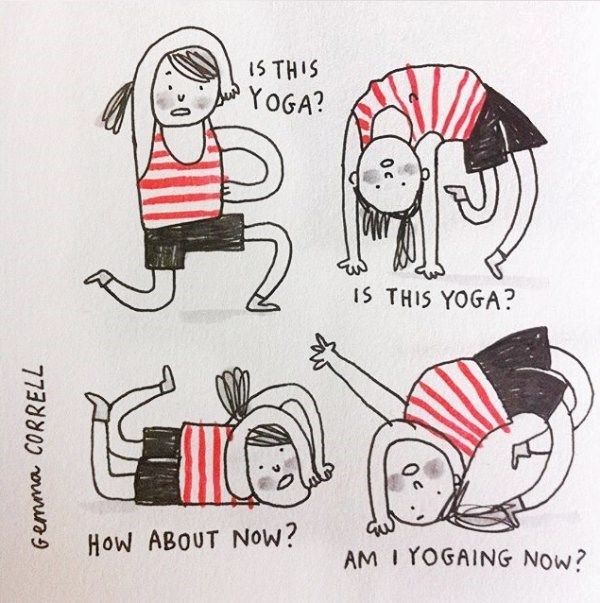Yoga is a practice that originated in ancient India. It was introduced to the United States in the 1890s but didn’t begin to gain mainstream popularity until the 1950s and 60s. By the 1970s, yoga studios could be found in many parts of the of the country. Today, yoga is found in schools, workplaces and even virtually.
The word “yoga” comes from Sanskrit (Sanskrit is the language of yoga) and is most commonly translated to mean “yoke,” as in “to join or bind together.” A yoke is a wooden beam used to fasten animals, such as oxen, together with a cart or load they are pulling. In yoga terms, we yoke or bring together the mind, body and spirit in our practice.
Another, less common translation of the word “yoga” is “discipline.” This is my preferred definition. Often, we use the word “discipline” as a synonym for “punishment”. I’m sure some people see the headstands, arm balances and Twister-like contortions of yoga as a type of punishment. When I use the word “discipline,” though, I mean “discipline” as in commitment, consistency and dedication. Through my regular yoga practice, I find a stronger body, a less frazzled mind and a calmer spirit. When I am dedicated to my practice, I make better food choices, I drink less alcohol and I sleep better. When I am less than “disciplined,” I notice the difference.

The goal of yoga is to calm to mind and turn inward, something I think most of us could benefit from. What most people think of when they think of yoga – the poses or postures, like downward dog or tree pose – is not yoga. The postures are part of yoga, called asana. Practicing asana in conjunction with breathwork (pranayama) and meditation is yoga. (Meditation can have several different Sanskrit names, depending on the type of practice you’re engaged in.) Yoga, as a way of life, has other guidelines that teach students how to live their lives in relation to themselves and other people, but for most people who just want to take some yoga classes, it’s not necessary to get into those details. (Check out this link if you’re interested.)
Anyone can practice yoga. Yoga is not a religion, nor does it require you to practice any particular religion to be involved in it. Yoga is not just for people who are naturally flexible. It is not just for young people or just for older people. Yoga is not just stretching or just an exercise class. And yoga has amazing health benefits for everyone who practices it.
The type of yoga that is practiced the most in the West is hatha yoga. Hatha links movement with breath. Meditation is generally done at the beginning and end of class. It can be thought of as an umbrella term under which you’ll find class descriptions such as yin, vinyasa and restorative. All these class types link movement and breath, at different paces. (Yin is slow-paced, vinyasa is fast-paced and restorative is very, very slow, with relaxed postures held for as long as ten or fifteen minutes.) You might see hatha in a description of a yoga class. If you do, know that when used in a class description, hatha generally indicates a medium paced class, where postures are held for a few breaths.
All types of hatha yoga provide health benefits. Let’s get into the details.
Yoga improves flexibility
No surprise here. You don’t need to be a flexible person to start doing yoga. Yoga will make you more flexible. Flexibility is something we can build at any age, so the best time to start practicing yoga is now. When done consistently, yoga increases range of motion, reduces risk for injury and improves posture. Poor posture is linked to back and shoulder pain, shortness of breath, digestive issues and even incontinence and constipation. (It’s not just about looking nice or being able to balance a book on your head.)
Since poses are generally held for a length of time, the muscles, joints, tendons and fascia are able to relax into the stretch, allowing you reap greater benefits. Even vinyasa yoga, which is faster-paced and doesn’t hold a pose for as long, improves flexibility because the linked, dynamic movements warm up the muscles, which allows for greater movement. Flexibility is hugely important, especially as we get older. Flexibility is what allows us to bend down to pick something up when we drop it, reach up to a high grocery store shelf and turn our heads to look over our shoulders. Flexibility allows us to be active and independent longer. It isn’t about being able to touch your toes – that’s great, but what we really want is to be able to tie our own shoes. Flexibility is about function.
Yoga improves balance
Yoga improves strength, especially in the leg muscles and the core. The leg muscles – the quadriceps, hamstrings and glutes – are the largest muscles in our bodies. When those muscles are strong, we have a solid base. The core muscles – the muscles of the abdomen, lower back and hips – are the stabilizers. When we are taken off balance, they work to right us. Try this – in a safe space, like standing at your kitchen counter, balance on one foot. (You can grab the counter for support if you think you might fall.) As you’re balancing, notice which muscles are working. They’ll feel shaky. It’s not the muscles in your standing leg. It’s the muscles of your core. Their job is to keep you upright.
All standing yoga postures utilize the leg muscles and almost all the postures, regardless of orientation, utilize the core muscles. Strengthening these muscles improves balance and good balance prevents falls – a major concern as we get older. Falls commonly lead to fractures among older adults. Falls are the reason that both of my parents are in assisted living facilities. Nobody wants that, not if we can avoid it.
Yoga improves heart health
We don’t think of yoga as “cardio”. Unless you’re doing a fast-paced vinyasa class, you might not even break a sweat. Yet yoga has very real heart-healthy benefits. The slow, measured breathwork lowers the heart rate and blood pressure. Yoga reduces stress levels by activating the body’s parasympathetic nervous system. When we’re stressed, the body’s sympathetic nervous system is on duty. This is the “fight or flight” response we’re familiar with. It leads to inflammation and increased blood pressure levels. The parasympathetic nervous system operates the “rest and digest” response. When we practice yoga, our bodies are able to relax and let go. The deep breathing and mediation of yoga allow the parasympathetic nervous system to do its job.
Reduced levels of inflammation are also the likely reason that some studies have linked yoga to reduced levels of cholesterol and triglycerides as well. Many cardiac rehab programs now incorporate yoga into their practices due to its cardiac and stress-relieving benefits.
Yoga improves self-image
Yoga boosts self-awareness in incredible ways. Yoga is non-judgmental. There’s no goals or points to score in yoga. There’s no winners and losers. There’s no finish line. There’s just you and your mat, your instructor and your fellow students. Your fellow students are not looking at you. I promise. Try staring at your neighbor while you’re in tree pose. You’ll fall over. It just isn’t possible.
Yoga studios usually have no mirrors. This really confused me when I first started practicing. How are you supposed to know if you’re doing it right if you can’t see what you’re doing? I thought. Then I learned – it doesn’t matter how the pose looks. What matters is how the pose feels.
Once you shift to this mindset, you never go back. It gives you a completely different attitude towards your own body. You start to notice little things. How funny, you might say to yourself. Yesterday I could reach my toes and today I can’t. I wonder why? What would happen if I bent my knees a little more? Or a pose makes you feel the tightness in your shoulder or how good it feels to lean your neck that way. You become aware of the things your body can do instead of how your body looks. Yoga helps us to be less critical and more appreciative of our bodies. When we appreciate things, we take better care of them.

Yoga encourages mindfulness
Mindfulness is the practice of being in the moment, being aware of what’s going on around and within us without judgment. Yoga encourages this practice through movement and cueing. The instructor will remind you to come back to the moment, with cues to pause and notice a sensation or guide your mind back if it’s wandered off. This mindfulness carries over to our everyday lives. If we practice mindfulness on our mats in a safe environment, it becomes easier for us to practice it in the real world.
Getting started with yoga has never been easier. Wonderful local yoga studios are all over Western New York. On-demand videos abound online. Private yoga instruction is also available for those who prefer. However you practice, yoga provides an astounding array of benefits – physically, mentally and emotionally.
Thanks for being with me on this wellness journey.


Leave a Reply